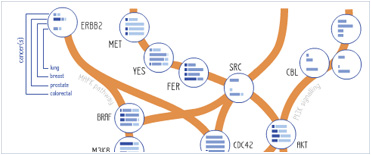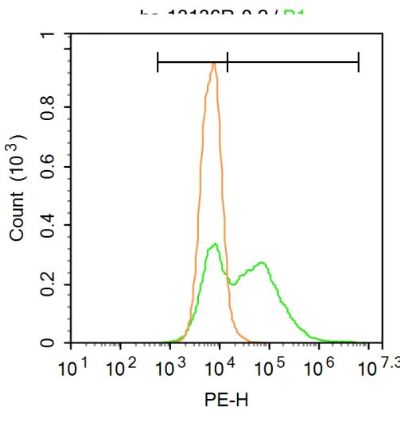NEDD4 Polyclonal Antibody
Purified Rabbit Polyclonal Antibody (Pab)
- SPECIFICATION
- CITATIONS
- PROTOCOLS
- BACKGROUND

Application
| WB, IHC-P, IHC-F, IF, ICC, E |
|---|---|
| Primary Accession | P46934 |
| Reactivity | Rat, Pig, Dog, Bovine |
| Host | Rabbit |
| Clonality | Polyclonal |
| Calculated MW | 145 KDa |
| Physical State | Liquid |
| Immunogen | KLH conjugated synthetic peptide derived from human SRD5A2 |
| Epitope Specificity | 801-900/1319 |
| Isotype | IgG |
| Purity | affinity purified by Protein A |
| Buffer | 0.01M TBS (pH7.4) with 1% BSA, 0.02% Proclin300 and 50% Glycerol. |
| SUBCELLULAR LOCATION | Cytoplasm. Cell membrane; Peripheral membrane protein. Note=Recruited to the plasma membrane by GRB10. Once complexed with GRB10 and IGF1R, follows IGF1R internalization, remaining associated with early endosomes. Uncouples from IGF1R-containing endosomes before the sorting of the receptor to the lysosomal compartment. May be recruited to exosomes by NDFIP1.. |
| SIMILARITY | Contains 1 HECT (E6AP-type E3 ubiquitin-protein ligase) domain.Contains 4 WW domains. |
| SUBUNIT | Interacts with UBE2D2. Binds SCNN1A, SCNN1B and SCNN1G. Binds, in vitro, through the WW2 and WW3 domains, to neural isoforms of ENAH that contain the PPSY motif. Interacts with BEAN1, LITAF, RNF11, WBP1, WBP2, TMEPAI and PRRG2 (By similarity). Interacts with NDFIP1 and NDFIP2; this interaction activates the E3 ubiquitin-protein ligase and may induce its recruitment to exosomes. Interaction with PTEN is questionable according to PubMed:18562292. Interacts with viral proteins that contain a late- budding motif P-P-P-Y. This interaction is essential for viral particle budding of a lot of retroviruses, like HTLV-1 Gag and MLV Gag. Interacts (via C2 domain) with GRB10 (via SH2 domain). Interacts with ERBB4. Interacts with TNIK; the interaction is direct, allows the TNIK-dependent recruitment of RAP2A and its ubiquitination by NEDD4. Interacts (via WW3 domain) with TNK2; EGF promotes this interaction. Interacts (via WW3 domain) with FGFR1 (via C-terminus). |
| Post-translational modifications | Auto-ubiquitinated. |
| Important Note | This product as supplied is intended for research use only, not for use in human, therapeutic or diagnostic applications. |
| Background Descriptions | E3 ubiquitin-protein ligase which accepts ubiquitin from an E2 ubiquitin-conjugating enzyme in the form of a thioester and then directly transfers the ubiquitin to targeted substrates. Involved in the pathway leading to the degradation of VEGFR-2/KDFR, independently of its ubiquitin-ligase activity. Monoubiquitinates IGF1R at multiple sites, thus leading to receptor internalization and degradation in lysosomes. According to PubMed:18562292 the direct link between NEDD4 and PTEN regulation through polyubiquitination described in PubMed:17218260 is questionable. Involved in ubiquitination of ERBB4 intracellular domain E4ICD. Involved in the budding of many viruses. Part of a signaling complex composed of NEDD4, RAP2A and TNIK which regulates neuronal dendrite extension and arborization during development. Ubiquitinates TNK2 and regulates EGF-induced degradation of EGFR and TNF2. |
| Gene ID | 4734 |
|---|---|
| Other Names | E3 ubiquitin-protein ligase NEDD4, 2.3.2.26, Cell proliferation-inducing gene 53 protein, HECT-type E3 ubiquitin transferase NEDD4, Neural precursor cell expressed developmentally down-regulated protein 4, NEDD-4, NEDD4, KIAA0093, NEDD4-1 |
| Dilution | WB=1:500-2000,IHC-P=1:100-500,IHC-F=1:100-500,ICC=1:100-500,IF=1:100-500,Flow-Cyt=3ug/test,ELISA=1:5000-10000 |
| Format | 0.01M TBS(pH7.4), 0.09% (W/V) sodium azide and 50% Glyce |
| Storage | Store at -20 ℃ for one year. Avoid repeated freeze/thaw cycles. When reconstituted in sterile pH 7.4 0.01M PBS or diluent of antibody the antibody is stable for at least two weeks at 2-4 ℃. |
| Name | NEDD4 |
|---|---|
| Synonyms | KIAA0093, NEDD4-1, RPF1 {ECO:0000303|Pub |
| Function | E3 ubiquitin-protein ligase which accepts ubiquitin from an E2 ubiquitin-conjugating enzyme in the form of a thioester and then directly transfers the ubiquitin to targeted substrates. Specifically ubiquitinates 'Lys-63' in target proteins (PubMed:19920177, PubMed:21399620, PubMed:23644597). Involved in the pathway leading to the degradation of VEGFR-2/KDFR, independently of its ubiquitin-ligase activity. Monoubiquitinates IGF1R at multiple sites, thus leading to receptor internalization and degradation in lysosomes (By similarity). Ubiquitinates FGFR1, leading to receptor internalization and degradation in lysosomes (PubMed:21765395). Promotes ubiquitination of RAPGEF2 (PubMed:11598133). According to PubMed:18562292 the direct link between NEDD4 and PTEN regulation through polyubiquitination described in PubMed:17218260 is questionable. Involved in ubiquitination of ERBB4 intracellular domain E4ICD (By similarity). Part of a signaling complex composed of NEDD4, RAP2A and TNIK which regulates neuronal dendrite extension and arborization during development (By similarity). Ubiquitinates TNK2 and regulates EGF-induced degradation of EGFR and TNF2 (PubMed:20086093). Ubiquitinates BRAT1 and this ubiquitination is enhanced in the presence of NDFIP1 (PubMed:25631046). Ubiquitinates DAZAP2, leading to its proteasomal degradation (PubMed:11342538). Ubiquitinates POLR2A (PubMed:19920177). Functions as a platform to recruit USP13 to form an NEDD4-USP13 deubiquitination complex that plays a critical role in cleaving the 'Lys-48'-linked ubiquitin chains of VPS34 and then stabilizing VPS34, thus promoting the formation of autophagosomes (PubMed:32101753). |
| Cellular Location | Cytoplasm. Nucleus. Cell membrane {ECO:0000250|UniProtKB:P46935}; Peripheral membrane protein {ECO:0000250|UniProtKB:P46935}. Note=Predominantly cytoplasmic but also located in the nucleus (PubMed:11342538). Recruited to the plasma membrane by GRB10. Once complexed with GRB10 and IGF1R, follows IGF1R internalization, remaining associated with early endosomes. Uncouples from IGF1R-containing endosomes before the sorting of the receptor to the lysosomal compartment (By similarity). May be recruited to exosomes by NDFIP1 (PubMed:18819914). {ECO:0000250|UniProtKB:P46935, ECO:0000269|PubMed:11342538, ECO:0000269|PubMed:18819914} |

Thousands of laboratories across the world have published research that depended on the performance of antibodies from Abcepta to advance their research. Check out links to articles that cite our products in major peer-reviewed journals, organized by research category.
info@abcepta.com, and receive a free "I Love Antibodies" mug.
Provided below are standard protocols that you may find useful for product applications.
If you have used an Abcepta product and would like to share how it has performed, please click on the "Submit Review" button and provide the requested information. Our staff will examine and post your review and contact you if needed.
If you have any additional inquiries please email technical services at tech@abcepta.com.













 Foundational characteristics of cancer include proliferation, angiogenesis, migration, evasion of apoptosis, and cellular immortality. Find key markers for these cellular processes and antibodies to detect them.
Foundational characteristics of cancer include proliferation, angiogenesis, migration, evasion of apoptosis, and cellular immortality. Find key markers for these cellular processes and antibodies to detect them. The SUMOplot™ Analysis Program predicts and scores sumoylation sites in your protein. SUMOylation is a post-translational modification involved in various cellular processes, such as nuclear-cytosolic transport, transcriptional regulation, apoptosis, protein stability, response to stress, and progression through the cell cycle.
The SUMOplot™ Analysis Program predicts and scores sumoylation sites in your protein. SUMOylation is a post-translational modification involved in various cellular processes, such as nuclear-cytosolic transport, transcriptional regulation, apoptosis, protein stability, response to stress, and progression through the cell cycle. The Autophagy Receptor Motif Plotter predicts and scores autophagy receptor binding sites in your protein. Identifying proteins connected to this pathway is critical to understanding the role of autophagy in physiological as well as pathological processes such as development, differentiation, neurodegenerative diseases, stress, infection, and cancer.
The Autophagy Receptor Motif Plotter predicts and scores autophagy receptor binding sites in your protein. Identifying proteins connected to this pathway is critical to understanding the role of autophagy in physiological as well as pathological processes such as development, differentiation, neurodegenerative diseases, stress, infection, and cancer.



